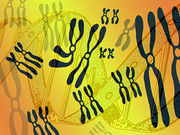Efficient vector marking in bone marrow CD34+ cells, myeloid cells, B cells in newly diagnosed SCID
MONDAY, Dec. 11, 2017 (HealthDay News) — A new approach to gene therapy can restore immune cell types in infants with newly diagnosed X-linked severe combined immunodeficiency (X-SCID), according to a study presented at the annual meeting of the American Society of Hematology, held from Dec. 9 to 12 in Atlanta.
Ewelina Mamcarz, M.D., from the Children’s National Medical Center in Memphis, Tenn., and colleagues developed a new approach for X-SCID gene therapy using a safety-modified lentiviral vector together with reduced exposure busulfan (Bu) conditioning for newly diagnosed infants with X-SCID. Six subjects were enrolled over 12 months. Purified bone marrow (BM) CD34+ cells were transduced with the vector generated by a stable producer cell line, which was cryopreserved. Patients were given a median dose of 8.06 × 106 cells/kg transduced CD34+ cells.
The researchers observed no severe adverse events related to BM harvest, Bu exposure, or cell infusion as of July 2017. In the first five evaluable cases, by three to four weeks, complete hematopoietic recovery occurred without any blood product support. In most cases, rapid T cell reconstitution was seen. In addition, there was efficient vector marking in BM CD34+ cells, myeloid cells, and B cells.
“It is very exciting that we observed restoration of all three very important cell types in the immune system,” Mamcarz said in a statement. “This is something that’s never been done in infants and a huge advantage over prior trials.”
Several authors disclosed financial ties to the biopharmaceutical industry.
Copyright © 2017 HealthDay. All rights reserved.








